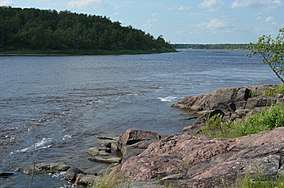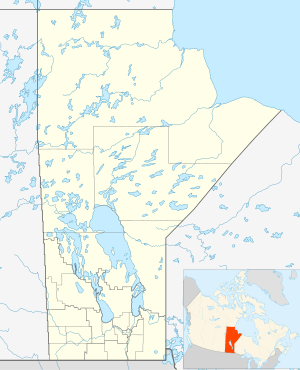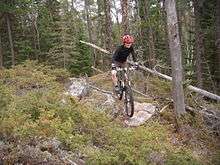Whiteshell Provincial Park
Whiteshell Provincial Park is a 2,721 km2 park centrally located in Canada in the province of Manitoba. It is found in the southeast region of the province along the Manitoba-Ontario boundary, approximately 130 km east of the city of Winnipeg. The park is located in the Canadian Shield region and has many rivers, remote lakes, boreal forest and bare granite ridges. It has rare archeological sites of petroforms on flat granite ridges. The park is used year-round for nature-oriented recreation activities.[1]
| Whiteshell Provincial Park | |
|---|---|
IUCN category II (national park) | |
 Whiteshell river within the park | |
 | |
| Location | Manitoba, Canada |
| Nearest city | Winnipeg, Manitoba |
| Coordinates | 49.55°N 95.20°W |
| Area | 2,721 km2 (1,051 sq mi) |
| Established | 1961 |
| Governing body | Government of Manitoba |
Whiteshell Provincial Park was designated a provincial park by the Government of Manitoba in 1961.[2] The park is considered to be a Class II protected area under the IUCN protected area management categories.[3]
History
The Ojibway people and various other groups before them initially populated the area. The Ojibway, or Anishinaabe, first mapped some of the area on birch bark. The name of the park is derived from the cowrie shells that were used in ceremonies by the Anishinaabe, including the Ojibway, and among them the Midewiwin practitioners. The historic Winnipeg River and the Whiteshell River are the main rivers that run through the park. For thousands of years, aboriginal peoples used the area for harvesting wild rice, hunting, fishing, trade, ceremonies, teaching, and dwelling. In 1734, La Vérendrye was the first European to explore the area during his quest for a route to the Western Sea. First Nations, fur traders, and trappers used the Winnipeg River as the main travel route through this area, as well as the Whiteshell River.
Whiteshell Provincial Park has many pink granite ridges, cliffs, and flat granite areas used for petroform making by First Nation peoples. There is also archaeological evidence of ancient copper trading, prehistoric quartz mining, and stone tool making in the area. The copper trade, which extended toward Lake Superior, began approximately 6,000 years ago. Many artifacts and prehistoric camps were discovered in Whiteshell Provincial Park and are protected under the Heritage Act of Manitoba. The park is still used by aboriginal peoples for wild rice harvesting and ceremonies.
Around 1920, the development of roads brought tourists into the Whiteshell area. The first summer cottages were close to the Canadian Pacific Railway and the Canadian National Railway. In 1922 Brereton Lake Dominion Park was created. A decade later and in 1930 the park was transferred to the province of Manitoba and established the Whiteshell Forest Reserve. Further roadwork continued, linking the reserve to Ontario in the east and campgrounds and picnic sites further north. In 1961, Whiteshell was given Provincial Park status. A Manitoba Historical Plaque was erected at the Whiteshell Provincial Park by the province to commemorate Dawson Road's role in Manitoba's heritage.[4]
Geography
Lakes
Whiteshell Provincial Park contains thirteen main freshwater lakes which are used for recreation such as boating, watersports and angling. These lakes are:
- Falcon Lake
- West Hawk Lake
- Caddy Lake
- Brereton Lake
- War Eagle Lake
- Jessica Lake
- Green Lake
- White Lake
- Big Whiteshell Lake
- Betula Lake
- Nutimik Lake
- Dorothy Lake
- Eleanor Lake
- Star Lake
- Red Rock Lake
There are many more remote lakes throughout the park that are not easily accessible, such as George Lake, Crowduck Lake, and Horseshoe Lake.
Falcon Lake
The main park entrance is located at Falcon Lake, immediately south of the Trans-Canada Highway.[5] Falcon Lake has three provincially operated campgrounds, a beach, golf course, ski resort, riding stables and many other tourist services.[5] It is the west end of Manitoba Provincial Road 301 which runs east through Faloma, Toniata, and Star Lake to the community of West Hawk Lake.[5]
West Hawk Lake
- Scuba diving – West Hawk Lake, the deepest lake in the province, was formed by a meteorite, and is a popular spot for scuba diving and ice diving.
West Hawk Museum
Located at West Hawk Lake, the West Hawk Museum features exhibits about the area's geology, area gold mining, and the formation of the lake from the impact of meteorite that formed the West Hawk crater.
Whiteshell Fish Hatchery Interpretive Centre
The Whiteshell Fish Hatchery Interpretive Centre allows visitors to learn about the hatchery's activities in raising lake sturgeon, trout and walleye. The hatchery is located along the Whiteshell River just north of West Hawk Lake. The fish in the hatchery are used to help stock lakes throughout Manitoba. It is open during the summer months.
Rennie
Alfred Hole Goose Sanctuary
The Alfred Hole Goose Sanctuary and Interpretive Centre is located at PTH 44, slightly east of Rennie. The sanctuary protects nesting Canada geese each spring. The interpretive centre provides information about the biology of the geese and the history of the sanctuary, as well as an observation gallery for the lake and interpretive programs.
Whiteshell Trappers Museum
The Whiteshell Trappers Museum is located on the grounds of the Alfred Hole Goose Sanctuary. Built in 1997, the museum resembles a fur trapper's cabin. Interpreters discuss the history of fur trapping, trapping techniques, and local wildlife.
Nutimik Lake
Whiteshell Natural History Museum
The Whiteshell Natural History Museum, opened in 1960 and located in a log building, features mounted wildlife displays of local animals. Other displays include the boreal forest, Canadian Aboriginal peoples, petroforms, sturgeon and the Winnipeg River. The museum is open during the summer season, and is located on PR 307 at Nutimik Lake. Admission is free.
Ecology
Fauna
Whiteshell Provincial Park is home to a variety of large mammals including black bear, moose, white-tailed deer, timber wolf and lynx. Smaller mammals such as river otter, marten, fisher, red fox, mink, hare, beaver, bats, skunk, raccoon, muskrat and red squirrels also inhabit the park. The birds in the park include owls, bald eagles, ruby throated hummingbirds, chickadees, blue jays, grosbeaks, turkey vultures, redpolls, woodpeckers, osprey, loons, ruffed grouse, ducks and Canada geese. Snakes, turtles and a wide variety of insects are found in the park. The lakes and rivers contain perch, walleye, jackfish, lake sturgeon, black crappie, burbot, whitefish, trout, white bass, smallmouth bass and mooneye. Smoked mooneye meat is highly valued and sold as "Winnipeg goldeye".
Activities
The park may be accessed from the south side via the Trans-Canada Highway (Hwy 1), where visitors will enter near Falcon Lake and West Hawk Lake. The park may also be accessed from the west side via Provincial Road 307 at Seven Sisters Falls or Provincial Trunk Highway 44 at Rennie.[6] The other major highway in the park, Provincial Road 309, connects Provincial Road 307 at White Lake with Lone Island Lake and Big Whiteshell Lake. The park is located along the eastern side of Southern Manitoba, along the Ontario border. When arriving in Manitoba from the east, it is the first area that is entered, along the Trans-Canada Highway. There is one road that enters into Manitoba from the east side due to the difficult Canadian Shield terrain and efforts to protect the park areas.
Park vehicle permits are typically required year-round in Manitoba Provincial Parks. Permits are available at all campgrounds and district offices, as well as most business locations where fishing and hunting licenses are sold.

- Boating – Boat launches are accessible at a variety of lakes and many resorts offer boat rentals.
- Canoeing and kayaking – Up to 325 km of canoe routes are located within the park. Paddlers on the Caddy Lake Canoe Route pass through tunnels in a wall of rock that were created when the railways came through this area more than a century ago.
- Cottages, Cabins, Lodges and Resorts - The population in the park increases significantly in the summer. Many of these seasonal residents own cottages or cabins built on land leased from the Crown. The word 'cottaging' is used to describe staying at these seasonal residences. Visitors to the park who are not interested in camping can choose to rent a cottage or cabin or stay in a lodge or resort.[7]
- Camping – Camping is available at multiple sites in the park. Camping fees vary depending on facilities and services provided. Reservations must be made through the Parks Reservation Service.
- Cycling – A 4.2 km loop is available at Betula Lake on Provincial Road 307 and a 9 km trail at Big Whiteshell Lake on Provincial Road 309. The South Whiteshell Trail is a multi-use trail system that accommodates cyclists. When completed, the trail will connect Falcon Lake to Caddy Lake and will be approximately 29 kilometres in length.
- Fishing and icefishing – There are a dozen species of fish that will provide fishing enjoyment. The best known species of fish in this section of the Winnipeg River System is the lake sturgeon. They are bottom feeders and can reach lengths of up to 3 metres long and be well over 100 years old.[8] Lake sturgeon are an endangered species and must be released upon catching them.
- Hiking – Trails range from short 1.5 km routes to the more challenging 60 km Mantario Trail, connecting Caddy Lake with Block 2 of Big Whiteshell Lake.[9] Part of the Trans-Canada Trail is contained in the park, although construction is incomplete.
- Sailing and boardsailing – Falcon Lake and West Hawk Lake maintain sailing clubs.
- Snowmobiling – Over 200 km of marked and groomed snowmobiling trails offer winter recreation.
- Snowshoeing – In winter, this snow allows for snowshoeing on the trail systems and on the frozen lakes.
- Swimming – Numerous public beaches permit swimming and many lakeside cottages allow swimming at the shoreline area.
Gallery
 Pelicans on Big Whiteshell Lake
Pelicans on Big Whiteshell Lake Big Whiteshell Lake in the Fall
Big Whiteshell Lake in the Fall Longpine Creek
Longpine Creek Sampson's Cove
Sampson's Cove McHugh Lake Loop
McHugh Lake Loop- Sand Art at West Hawk Lake
References
- A System Plan for Manitoba's Provincial Parks (PDF). Government of Manitoba. 1998. p. 56. Retrieved 1 July 2017.
- "Whiteshell Provincial Park". Find Your Favourite Park. Government of Manitoba. Retrieved 1 July 2017.
- "Whiteshell Provincial Park". Protected Planet. United Nations Environment World Conservation Monitoring Centre. Retrieved 30 June 2017.
- Manitoba Plaque
- "Falcon Lake Townsite Map" (PDF). Government of Manitoba. Retrieved 29 December 2019.
- "Parks and Protected Spaces | Sustainable Development | Province of Manitoba". Retrieved 2017-09-19.
- "Adventures await you in lake livin' country!". Falcon and Westhawk Lake Livin'. Falcon and West Hawk Chamber of Commerce. Retrieved 1 July 2017.
- http://www.wcscanada.org/Wildlife/LakeSturgeon.aspx#.VB2wFJVI5XE
- http://www.naturemanitoba.ca/mantario-hiking-trail
External links
| Wikimedia Commons has media related to Whiteshell Provincial Park. |
- Whiteshell Provincial Park - official site
- Visit Whiteshell Provincial Park - tourism site
- Whiteshell Provincial Park - tourism site
- Whiteshell Natural History Museum
- Alfred Hole Goose Sanctuary and Interpretive Centre
- West Hawk Museum
- Whiteshell Fish Hatchery Interpretive Centre
- iNaturalist.org:Observations in Whiteshell Provincial Park